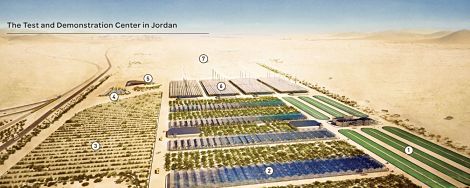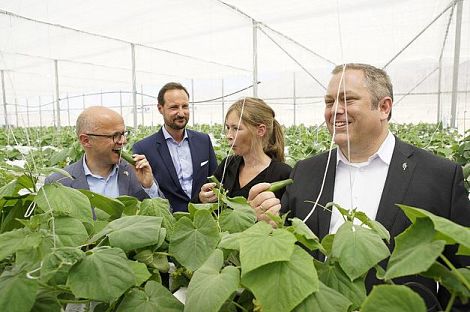
The SFP is part-funded by the EU and the Norwegian government. Last month, Jordan’s King Abdullah II and Norway’s Crown Prince Haakon attended the SFP’s official opening ceremony. The SFP Launch Station in Jordan will be the size of four football fields, and include features such as saltwater-cooled greenhouses, research facilities, outdoor vegetation zones, and a solar power plant. The centre will be a place for local training and innovation, and SFP will cooperate closely with regional and international players to find good solutions. The launch station is a first step towards the creation of a 20 hectare facility in southern Jordan.
In this first stage, the SFP aims to produce up to 130 tonnes of organic vegetables per year from just 7 acres of previously-deemed ‘unusable’ land. The full scale of the project is set to reach 490 acres in the coming years.
The project will have a number of functions upon completion. It will operate energy and water efficient saltwater-cooled greenhouses for growing high-value crops in the desert, produce freshwater for irrigation or drinking, safely manage brine and harvest useful compounds from the resulting salt, grow biomass for energy purposes without competing with food cultivation and revegetate desert lands. In addition to its commodity outputs of food, energy and salt, the project will also provide global climate benefits by sequestering CO2 in the facility’s plants and soils and pushing back desertification through the revegetation of desert areas.
The three core components of the SFP will be the saltwater-cooled greenhouses that provide suitable growing conditions enabling year-round cultivation of high-value vegetable crops in desert conditions, Concentrated Solar Power (CSP) for electricity and heat generation, and technologies for desert revegetation.
By using seawater to provide evaporative cooling and humidification, crop water requirements will be minimised and yields maximised with a minimal carbon footprint.

1. Algae-facility; 2. Saltwater based Greenhouses; 3. External vegetation and evaporative hedges; 4. Designed stepped protection for flash floods; 5. Facilities for research and accommodation; 6. Concentrated Solar Power facilities; 7. Evaporative ponds
The project technologies for desert revegetation will consist of a collection of practices and technologies for establishing outside vegetation in arid environments, such as evaporative hedges.
By establishing a commercially viable way to bring saltwater into the desert, the Sahara Forest Project will work as an enabling technology, creating opportunities for a wide range of businesses to develop alongside it. These will include salt extraction, traditional desalination, algae production, halophyte cultivation, PV, mariculture, bioenergy and more.
The synergies arising from integrating the technologies will improve performance and economics compared to those of the individual components.
Environmental engineering firm Max Fordham has been collaborating with the Sahara Forest Project since the start of the project in 2008. Initially the company carried out research into technical aspects of the project including thermodynamic analysis of the greenhouse (to provide optimum growing conditions for crops with minimum resource input), desalination techniques, and the potential climatic effects of adding moisture to desert air.

The research included building and operating an experimental rig in the Qatari desert, to verify conclusions in the field. This culminated in the development of a mathematical computer model of the entire Sahara Forest Project system, which Max Fordham and SFP then used to investigate resource flows through the system and projected investment costs and returns.
The second stage of the collaboration was focused on the engineering design of the Sahara Forest Project system, firstly for the Pilot Project in Qatar, which opened in 2012 and operated for a year, then more recently for the larger Launch Station recently opened in Jordan. Max Fordham designed the pioneering saltwater cooling system for the greenhouse, as well as the services infrastructure which joins up and enables the different energy and growing technologies which comprise the SFP system.
Max Fordham collaborated with leading experts on solar power, greenhouse operation and desalination to ensure all the components of the SFP system work optimally, allowing the system to be greater than the sum of its parts. The company also provided site engineers during the construction and operation of the Qatar Pilot, to help the local engineers building the Pilot understand the system, and adapt the design during the life of the project to overcome the unforeseen challenges that inevitably come with innovation of this type.

“This is a project that has great promise for the future” said Prince Haakon. “It is impressive to see how technology can be used in such a sustainable way to produce agricultural goods in a quite tough climate like here.”
Tom Bentham, Senior Partner at Max Fordham, added that the project is one of the most technically complex and satisfying projects the company has worked on.
Image: Crown Prince Haakon of Norway and His Majesty King Abdullah II inaugurate the first phase of the Sahara Forest Project Launch Station in Aqaba (Sahara Forest Project).
For additional information:

